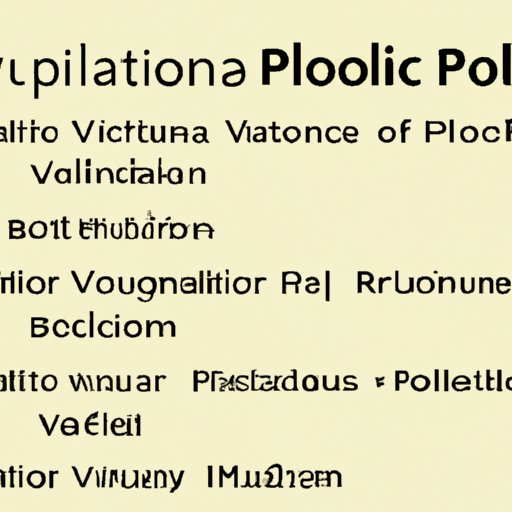Introduction
Poliomyelitis (polio) is an infectious disease caused by a virus. It can cause paralysis, muscle weakness, and even death in some cases. In the 20th century, polio was one of the most feared infectious diseases, and outbreaks occurred regularly in the U.S. and around the world. The introduction of the polio vaccine in 1955 marked a major turning point in the fight against this devastating disease, and today, polio has been almost completely eradicated in many parts of the world thanks to the widespread use of the vaccine.

Exploring How the Polio Vaccine Works
The polio vaccine works by stimulating the body’s immune system to produce antibodies that will fight off the virus if it enters the body. To understand how the vaccine works, it helps to first understand a bit about the virus itself.
Understanding the Virus
Poliovirus is a member of the enterovirus family, which includes other viruses such as coxsackieviruses and echoviruses. These viruses are highly contagious and spread through contact with an infected person or contaminated objects. The virus enters the body through the mouth and multiplies in the intestines. From there, it can spread to the nervous system and cause paralysis.
How the Vaccine Works
The polio vaccine contains a weakened form of the virus, which stimulates the body’s immune system to produce antibodies that will fight off the virus if it enters the body. When a person is vaccinated, the weakened virus stimulates the production of antibodies, which then circulate in the bloodstream and protect the person from infection if they come into contact with the wild virus. The body is then able to recognize the virus and quickly destroy it before it can cause any harm.
Investigating the History of Polio and Its Vaccine
Polio has been around for thousands of years, but it wasn’t until the 1940s and 1950s that it became a major public health concern. In 1952, the largest outbreak of polio in U.S. history occurred, with more than 58,000 cases reported. This spurred a major effort to develop a vaccine, and in 1955, the first polio vaccine was licensed in the U.S. Since then, the vaccine has been used in countries around the world, leading to a dramatic decrease in the incidence of polio.
Analyzing the Ingredients in the Polio Vaccine
The polio vaccine contains a weakened form of the poliovirus. This weakened virus is not capable of causing polio, but it is still strong enough to stimulate the body’s immune system to produce antibodies that will fight off the virus if it enters the body. The vaccine also contains trace amounts of antibiotics and preservatives, which help prevent contamination of the vaccine.

Discussing the Benefits of the Polio Vaccine
The polio vaccine has been credited with saving millions of lives worldwide. By protecting individuals from polio, the vaccine has helped reduce the burden of the disease on communities, freeing up resources that can be used to fight other illnesses. Additionally, the vaccine has helped to reduce the economic costs associated with treating and caring for people with polio.
Understanding How the Polio Vaccine is Administered
The polio vaccine is typically given as an injection or as a series of oral drops. The injection is usually given in the arm or leg, and the oral drops are usually given directly into the mouth. Depending on the age and health of the individual, different schedules may be recommended for administering the vaccine.

Comparing Different Types of Polio Vaccines
There are several different types of polio vaccines, including inactivated polio vaccine (IPV), oral polio vaccine (OPV) and bivalent OPV. IPV is the most commonly used type of polio vaccine and is given as an injection. OPV is given as a series of oral drops, while bivalent OPV is a combination of IPV and OPV. Different countries have adopted different types of polio vaccines, depending on their particular needs and resources.
Conclusion
The polio vaccine has been a major medical breakthrough, and its widespread use has helped to nearly eradicate the disease in many parts of the world. By understanding the science behind the polio vaccine and how it works, we can better appreciate the importance of vaccination and continue to work towards a world free of polio.
(Note: Is this article not meeting your expectations? Do you have knowledge or insights to share? Unlock new opportunities and expand your reach by joining our authors team. Click Registration to join us and share your expertise with our readers.)
